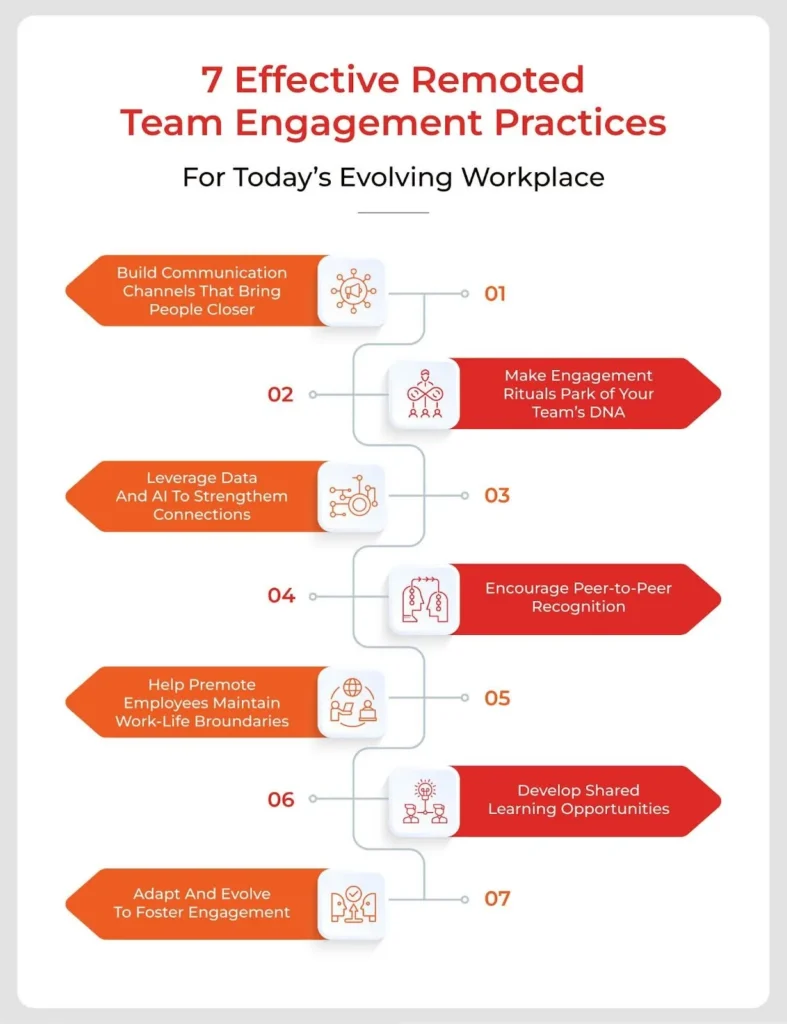Not long ago, team rapport was built over coffee breaks and spontaneous desk-side conversations. Now, as hybrid and fully remote work has become the norm, many leaders find themselves asking: Can we spark the same sense of connection, team motivation, and belonging when everyone’s just a face on a screen?
The answer: Absolutely yes, but it takes more than just technology. For HR professionals and team leads, employee engagement was once a “nice-to-have” but is now a strategic imperative, tied directly to retention, productivity, and culture.
As SPECTRAFORCE’s Engagement Team has experienced first-hand, sustaining connection in distributed teams requires intention. “When you’re working remotely, the interactions with your team involve more effort,” notes Samantha Kastenmeier. “You have to plan those touchpoints, and that changes the dynamic.”
Here are seven practices that have proven highly effective for remote team engagement in today’s evolving workplace.
Best Practices For Remote Team Engagement
1. Build Communication Channels That Bring People Closer
Ever felt that constant Slack pings and emails just become background noise? You’re not alone. In today’s remote world, information often drowns intention, and truly meaningful communication tends to get lost. The goal of remote team engagement efforts is to prioritize value over volume.
Distinguish between those messages that are “just business” and the ones that create virtual team culture or foster well-being. Collaboration tools like Slack or Microsoft Teams are the backbone of quick exchanges, but video calls still offer that essential human nuance.
As Cheree Bernard shares, “Having a separate channel outside of email is vital for sharing both positives and challenges.” This simple shift can reduce message fatigue, boost psychological safety, and keep your team engaged, without overwhelming them.
2. Make Engagement Rituals Your Team’s Secret Sauce
Think back: What’s one small ritual you looked forward to at your old office? Maybe a Friday lunch or a celebration for wins, no matter how small. These simple activities took workplace morale to the next level. Similarly, virtual teams also need remote team engagement rituals.
Imagine finishing a tough week, only to join your team for a 15-minute “coffee call” where everyone shares wins, challenges, and simply “what made you laugh this week.” Remote employees often look forward to such remote team engagement activities
Danielle Cunningham describes, “Our team makes intentional non-work-related calls to connect. A great example is a round table where each person shares something they contributed, something they gained, and one lighthearted moment from the week’” These moments, while simple, go a long way in keeping burnout at bay and letting remote employees know they’re more than just a name in a chat window.
3. Use Data and AI to Deepen (Not Replace) Human Connection
AI might seem impersonal, but in the right hands, it’s a tool that amplifies empathy. And it has the potential to shape the future of remote work.
Today’s leaders can spot disengagement before it becomes a problem: mood analytics in chat tools, AI-powered surveys, and automated check-ins mean even the quietest team members have a voice.
“Some team members may not feel comfortable speaking up during calls but can express themselves in written channels,” notes Samantha Kastenmeier. AI can help capture and interpret these signals so no one’s input gets overlooked.
While some managers may use these technologies to box people into metrics, they are best used to listen better. Doing so will allow you to tailor support and keep your finger on the team’s collective pulse.
For example, sentiment analysis in workplace communication channels allows managers to spot when energy drops.
Automated systems ensure feedback cycles include everyone instead of focusing just on the loudest contributors. The magic happens when AI insights nudge us to care more deeply, not less, and make remote team engagement regular and fun.

4. Foster Recognition That Flows in Every Direction
Recognition shouldn’t just trickle down from managers. The best virtual team cultures encourage peer-to-peer appreciation, where anyone can spotlight someone else’s contribution. Whether it’s a Bonusly point or a shoutout in Slack, these small gestures make a world of difference.
The diversity of personalities of remote employees makes this especially important. Offering written channels to people who may not be able to express themselves candidly over calls can help celebrate their efforts and innovation in a format that suits them. This way, you’re ensuring no one’s contributions get lost in the shuffle.
5. Draw the Line Between Work and Life And Help Others Do the Same
Remote work brings freedom, but also the risk of never really signing off. Leadership means modeling respect for boundaries like skipping that late-night email, or blocking off true “do-not-disturb” focus hours. These norms prevent burnout from sneaking in unnoticed and facilitate better employee engagement.
Kiely Hagen shares the payoff: “By setting up meetings intentionally, they’ve become smaller and more focused, which allows you to get close with a smaller group.” Fewer, shorter meetings mean your team can take real breaks. And that’s the key to not just surviving, but thriving.
6. Build Virtual Team Culture Through Shared Learning
In the past, shared learning meant conference rooms and back-to-back training days. Remotely, it’s about short, interactive bursts. Host “skill swap” sessions, let employees teach one another, or invite experts for focused discussions. These mini-learning moments drive engagement and professional growth, making every team member feel seen and invested in.
7. Treat Engagement as a Living Strategy, Adapt Along the Way
There’s no single formula for sustaining team energy and building better remote team connections. What works this quarter may not work the next. Check in with real participation metrics, survey responses, and informal feedback. Be transparent about any changes. Clarify why a certain meeting exists, or how input shaped a new ritual.
Danielle sums this rule of remote team engagement well: “Sharing the benefits of a specific meeting or project can help engage your team and have a motivating manager.” When teams see that their feedback leads to visible changes (whether it’s refining processes, adjusting workloads, or improving communication), they understand their input has real value. That tangible cause-and-effect builds trust and strengthens their commitment to shared goals.
To Conclude: Leading with Connection Is Essential and Worthwhile
Remote team engagement is a long-term investment in the heartbeat of your organization. The best results come when you combine old-school fundamentals of trust, recognition, and shared purpose ith the new advantages of modern tools, including AI.
At SPECTRAFORCE, we believe employee experience is everything, even in remote settings. That’s why our NEWJOBPHORIA® approach is all about helping distributed teams not just “get by,” but truly connect, thrive, and grow. Because wherever your people are, culture travels.
FAQs
How you build social connections in a remote team depends on creating deliberate moments that go beyond work tasks. Virtual coffee breaks, themed Slack channels, or short “show and tell” sessions let people share parts of themselves that rarely come up in project updates. These rituals(no matter how small) give remote employees a shared rhythm, making the team feel less like a set of individual contributors and more like a community.
The most effective ways to build team cohesion remotely combine consistent communication, shared learning opportunities, and transparent decision-making. Use both synchronous channels (like live video meetings) to capture real-time energy and asynchronous tools (like discussion boards) so every voice, regardless of time zone, can be heard. Layer in collaborative projects that cross functional lines to strengthen relationships across the organization.
Regular one-on-one video calls are crucial because they create space for candid conversations that often don’t surface in group settings. These meetings make it possible for managers to check in on both professional progress and personal well-being, tailoring support to each individual’s needs. In distributed teams, this dedicated face time can bridge the gap between “colleague” and “trusted partner,” fostering loyalty and openness.
The tools that support remote team engagement range from communication platforms to feedback systems. Slack, Microsoft Teams, Zoom, Bonusly, and Donut are reliable for day-to-day interaction and recognition. AI-powered platforms like Officevibe or Lattice go a step further by analyzing feedback patterns, offering leaders insight into team sentiment, and helping them act before disengagement sets in.
These engagement practices can work for hybrid teams too, provided they’re applied consistently across both in-office and remote staff. Rituals such as peer recognition, shared learning sessions, and intentional check-ins should be designed so that participation doesn’t depend on physical location. The goal is to ensure that hybrid structures don’t create two separate cultures, but one unified team experience.
How you measure remote team engagement should include both qualitative and quantitative approaches. Pulse surveys and open-ended feedback capture the human stories behind engagement, while metrics like participation in optional activities, response times in chats, and retention trends reveal patterns over time. Regular measurement provides the insight to adapt before problems escalate.



